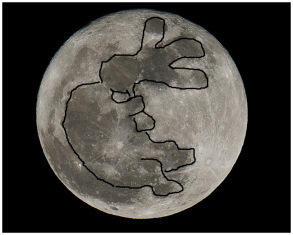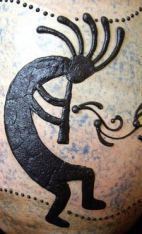Rose Anderson's Blog, page 34
April 20, 2014
Funday Sunday!
The A to Z returns Monday with letter R. Today is Funday!
I lead a busy life. To have one less mentally-busy day and still have a good time on this blog, I’ve decided Sundays will be all about wonder and smiles. In honor of mentally kicking back once in a while, Sundays will be Fun Days! Each Sunday, I’ll post a fun, interesting, or unusual something here. I’m a nerd with a complex sense of humor and absurd wit. It literally could be anything.
Today’s post shows the daily closing of the border between India and Pakistan. There’s no missing the longtime influence of the British Empire on the pomp and circumstance shown here. I wonder if their high stomps and posturing are remnants of India’s military culture before British colonialism. I must say, I do find the narrator rather rude. This is obviously a big deal to these two nations.
Come back tomorrow for more of the A to Z Challenge. Monday’s letter ~ R.
۞>>>>۞<<<<۞>>>>۞
 See what’s happening on the RB4U blog today
See what’s happening on the RB4U blog today
http://romancebooks4us.blogspot.com/
Our April contest is on. We’ll have 3 winners and a lot of prizes to split among them. http://www.romancebooks4us.com/
۞>>>>۞<<<<۞>>>>۞
Love Waits in Unexpected Places -
Scorching Samplings of Unusual Love Stories
https://www.smashwords.com/books/view/333971
Download your copy of my free chapter sampler!

۞>>>>۞<<<<۞>>>>۞<<<<۞>>>>۞<<<< ۞>>>>۞<<<<۞

April 19, 2014
The A to Z Challenge – Q for Quadratura, Trompe l’oeil, & Forced Perspective
 The A to Z Challenge is on! Hello and welcome to my Main blog. My name is Rose Anderson and I’m a romance novelist. Join me and more than 2279 bloggers and authors as we blog the alphabet throughout the month of April. My daily posts will be mostly history with some science topics here and there. I’ve chosen subjects that tickle my fancy, I hope you will find them interesting too.
The A to Z Challenge is on! Hello and welcome to my Main blog. My name is Rose Anderson and I’m a romance novelist. Join me and more than 2279 bloggers and authors as we blog the alphabet throughout the month of April. My daily posts will be mostly history with some science topics here and there. I’ve chosen subjects that tickle my fancy, I hope you will find them interesting too.
Keep the topic rolling! If you have comments or questions, add them at the end of the post. I may not know the answer off the top of my head but I love research and would enjoy discussing my topics further. Comments can be made just below my bio in the tag section.
*FREE* If you enjoy reading scorching romances with unique twists and characters full of personality and depth, scroll down for a free chapter sampler. Find my book trailers in the tabs above.
۞>>>>۞<<<<۞>>>>۞<<<<۞>>>>۞
 Today’s Calliope’s Writing Tablet post is brought to you by the letter Q ~
Today’s Calliope’s Writing Tablet post is brought to you by the letter Q ~
Q for Quadratura (And a little Trompe l’oeil, & Forced Perspective)
Since mankind first conceptualized his world on cave walls so many millennia ago, artists continue to convey emotion through artistic expression. It doesn’t matter the size, scope, medium, or subject. Man is driven to create art. I’ve wondered why that is since I was a girl strolling Chicago’s renown Art Institute. I do have my opinions. I believe it’s our self-awareness that drives us. We tap into something so much bigger than ourselves and art becomes meditation or prayer. I’m sure I’m not alone in making this observation. I’ve seen the divine concord in the brushstrokes of those masterpieces I grew up with. (I’ll share those thoughts in depth in my magnum opus –my enormous non-romance as-yet-unnamed work in progress.)
In my opinion as an art lover, there have been some stunning chapters in the sketchbook of mankind. I have a few favorites: The Classical era with its alabaster and marble sculpture so finely detailed you can see veils and curls. The Middle Ages with feats of artistic architecture. The Renaissance gave us light, and with it, keen perspective. The late Victorian era had the Belle Époque and light returned after a long hiatus. And the bold images of the Art Deco movement. These are the art movements that strike a chord in me.
Outside of specific eras where one or two styles were in vogue and everyone was trying their hand at them, there are some works of art I could get lost in. The nightmarish works of Hieronymus Bosch compel me to look for every demon and grim reaper hidden in the brushstrokes. Salvador Dali pulls at a point just between my eyes. I suppose the individual vignettes both artists fill their canvases with appeal to my ADD brain. lol And I’m sure were I to stare overlong at the works of M. C. Escher I might fall down that rabbit hole. Like I said, I could get lost in them. Some of my favorite artistic expressions have to do with tricking the eye. And that’s what today’s post is all about.
 There’s a mode of painting called Quadratura. When you pronounce it it’s pretty straight forward until you get to the t. The t is pronounced ch.
There’s a mode of painting called Quadratura. When you pronounce it it’s pretty straight forward until you get to the t. The t is pronounced ch.
Quadratura means to square. This has to do with painting walls and the angles involved. When I say that, I don’t mean painting the wall, I mean murals on the walls and ceilings. Illusions like these tricked the eye by visually extending the room’s actual architecture into an imaginary space beyond. The point was sotto in su meaning from below upwards.
 Trompe l’oeil, meaning deceive the eye, is less about extending walls than it is about depth. It tricks the eye into seeing flat paintings in 3-D. The Quadratura technique required an artist to have exceptional spatial skills and mastery of linear perspective. The amazing thing about this grand art style is the full impact of the scene is generally only visible from one vantage point.
Trompe l’oeil, meaning deceive the eye, is less about extending walls than it is about depth. It tricks the eye into seeing flat paintings in 3-D. The Quadratura technique required an artist to have exceptional spatial skills and mastery of linear perspective. The amazing thing about this grand art style is the full impact of the scene is generally only visible from one vantage point.
One of the more interesting techniques of this visual trickery is Forced Perspective. Example: Were you to lay the Sistine Chapel’s paintings flat rather than going with the curved ceiling vaults it was painted on, you’d see disproportionate and contorted bodies. By painting within the constraints of arcs and keeping the sotto in su in mind, Michelangelo created a stunning masterpiece meant to be seen from below. My small blog doesn’t do the grand images justice. I recommend looking these beauties up online or at the library.
A few examples of Quadratura:
The Palace of Versailles ceiling
Guercino’s Aurora
Correggio’s The Assumption of the Virgin
Andrea Pozzo’s The Apotheosis of St Ignatius
A few examples of Trompe l’oeil:
Michelangelo’s Sistine Chapel
Charles Willson Peale’s The Artist in His Museum
The ceiling in the Royal Palace of Madrid
Leonardo da Vinci’s The Last Supper
More~
The restoration of the Sistine Chapel
Seven things you may not know about the Sistine Chapel
Modern takes on Quadratura and Trompe L’oeil
An example of Forced Perspective in film
Tomorrow ~ letter R
۞>>>>۞<<<<۞>>>>۞<<<<۞
 See what’s happening on the RB4U blog today
See what’s happening on the RB4U blog today
http://romancebooks4us.blogspot.com/
Our April contest is on. We’ll have 3 winners and a lot of prizes to split among them. http://www.romancebooks4us.com/
۞>>>>۞<<<<۞>>>>۞<<<<۞
Love Waits in Unexpected Places -
Scorching Samplings of Unusual Love Stories
https://www.smashwords.com/books/view/333971
Download your copy of my free chapter sampler!

۞>>>>۞<<<<۞>>>>۞<<<<۞>>>>۞<<<< ۞>>>>۞<<<<۞>>>>۞<<<<۞



April 18, 2014
The A to Z Challenge – P for Phrenology
 The A to Z Challenge is on! Hello and welcome to my Main blog. My name is Rose Anderson and I’m a romance novelist. Join me and more than 2279 bloggers and authors as we blog the alphabet throughout the month of April. My daily posts will be mostly history with some science topics here and there. I’ve chosen subjects that tickle my fancy, I hope you will find them interesting too.
The A to Z Challenge is on! Hello and welcome to my Main blog. My name is Rose Anderson and I’m a romance novelist. Join me and more than 2279 bloggers and authors as we blog the alphabet throughout the month of April. My daily posts will be mostly history with some science topics here and there. I’ve chosen subjects that tickle my fancy, I hope you will find them interesting too.
Keep the topic rolling! If you have comments or questions, add them at the end of the post. I may not know the answer off the top of my head but I love research and would enjoy discussing my topics further. Comments can be made just below my bio in the tag section.
*FREE* If you enjoy reading scorching romances with unique twists and characters full of personality and depth, scroll down for a free chapter sampler. Find my book trailers in the tabs above.
۞>>>>۞<<<<۞>>>>۞<<<<۞>>>>۞
 Today’s Calliope’s Writing Tablet post is brought to you by the letter P ~
Today’s Calliope’s Writing Tablet post is brought to you by the letter P ~
P for Phrenology
Mankind has been around a while and from our earliest times we’ve sought to understand ourselves. When you compare us to the rest of the animal kingdom there are several ways we just  don’t make sense. Take childbirth. I can’t think of another mammal who goes through labor like humans do. Our large brain needs a large cranium to hold it. Needless to say, it’s no small feat to pass that through the birth canal. Thank goodness for those flexible fontanelles. Our big head weighs about the same as a bowling ball and we balance that bowling ball on the stem of our spine. That image makes me think of sunflowers. The stem bends under the weight of the blossom. Imagine that sunflower trying to walk!
don’t make sense. Take childbirth. I can’t think of another mammal who goes through labor like humans do. Our large brain needs a large cranium to hold it. Needless to say, it’s no small feat to pass that through the birth canal. Thank goodness for those flexible fontanelles. Our big head weighs about the same as a bowling ball and we balance that bowling ball on the stem of our spine. That image makes me think of sunflowers. The stem bends under the weight of the blossom. Imagine that sunflower trying to walk!
Just as our physiology has its incongruities, our paths to understanding ourselves have taken some pretty outrageous twists and turns as well. We’ve bled the ill humors from our veins. We’ve treated the mentally ill with ice baths and purges. We’ve dosed ourselves with poisons and completely nonsensical ingredients the likes of mercury and dog poop. And we’ve routinely surgically removed body parts without fully understanding their purpose (How many baby boomers are missing tonsils and adenoids?). Today’s post is about reading lumps and bumps on that big human head of ours.
What is Phrenology?
A psychological theory or analytical method based on the belief that certain mental faculties and character traits are indicated by the configurations of the skull. In other words — a quack science that involved deducing personality clues by the shape of one’s skull and the bumps found on the head.
Sometime in the late 1700′s a physician, one Franz Joseph Gall, made an observation: The cerebral cortex in animal brains were much small than that of human brains. This, he believed, was the key difference that separated us from them. A larger cerebral cortex made humans intellectually superior. But…not all humans were created equal. There were obvious ranges of intellect that spanned from complete idiot to genius. One of his burning questions was why did some people turned to crime? He convinced himself that these differences could be seen on the head if only one knew how to read them. Thus phrenology came into being.
Convinced the shape and texture of the skull was linked to personality and character, he tested his theory on a number of young pickpockets. By examining their heads, he deduced that many of them had bumps on their skull just above their ears. Of course this meant the tendency to steal, lie, and deceive was predetermined by those bumps.
Going further with his theory, he went looking for people with odd-shaped heads and measured the skulls of prison inmates and asylum patients. With this information, Gall developed a system of reading the head. He located twenty-seven specific parts of the head that keyed into what he referred to as Faculties, and created a chart that showed which areas of the skull were associated with specific traits or characteristics. A historical note: Phrenology and other skull studies figured heavily in institutional racism. I haven’t seen the movie but I hear such was recently depicted in the Oscar winning movie Django Unchained.
Gall’s list of Faculties and the corresponding chart:
Reproductive instincts
The love of one’s offspring
Affection and friendship
Self-defense, courage and fighting
Murderous instincts
Guile; acuteness; cleverness
Sense of property; the tendency to steal
Pride; arrogance; haughtiness; love of authority; loftiness
Vanity; ambition; love of glory
Circumspection; forethought
Aptitude for being educated
Sense of locality and place
Recollection of people
Verbal memory
Language ability
The sense of colors
Sense for sound and musical talent
Mathematical abilities
Mechanical abilities
Comparative sagacity
Metaphysics
Satire and wit
Poetic talent
Kindness; compassion; sensitivity; moral sense
Imitation and mimicry
Religiosity
Perseverance, firmness
 What do your bumps and lumps say about you? :D
What do your bumps and lumps say about you? :D
Although a pseudoscience, phrenology actually contributed to the field of neurology. In a quest to prove it wrong it was discovered certain mental functions are localized in particular areas of the brain. The lumps on the outside had nothing to do with it.
The Phrenology Machine is shown in this funny clip
More preposterous gadgets
https://www.youtube.com/user/MuseumofQuackery
Tomorrow ~ letter Q
۞>>>>۞<<<<۞>>>>۞<<<<۞
 See what’s happening on the RB4U blog today
See what’s happening on the RB4U blog today
http://romancebooks4us.blogspot.com/
Our April contest is on. We’ll have 3 winners and a lot of prizes to split among them. http://www.romancebooks4us.com/
۞>>>>۞<<<<۞>>>>۞<<<<۞
Love Waits in Unexpected Places -
Scorching Samplings of Unusual Love Stories
https://www.smashwords.com/books/view/333971
Download your copy of my free chapter sampler!

۞>>>>۞<<<<۞>>>>۞<<<<۞>>>>۞<<<< ۞>>>>۞<<<<۞>>>>۞<<<<۞



April 17, 2014
The A to Z Challenge – O for Organ Grinder
 The A to Z Challenge is on! Hello and welcome to my Main blog. My name is Rose Anderson and I’m a romance novelist. Join me and more than 2279 bloggers and authors as we blog the alphabet throughout the month of April. My daily posts will be mostly history with some science topics here and there. I’ve chosen subjects that tickle my fancy, I hope you will find them interesting too.
The A to Z Challenge is on! Hello and welcome to my Main blog. My name is Rose Anderson and I’m a romance novelist. Join me and more than 2279 bloggers and authors as we blog the alphabet throughout the month of April. My daily posts will be mostly history with some science topics here and there. I’ve chosen subjects that tickle my fancy, I hope you will find them interesting too.
Keep the topic rolling! If you have comments or questions, add them at the end of the post. I may not know the answer off the top of my head but I love research and would enjoy discussing my topics further. Comments can be made just below my bio in the tag section.
*FREE* If you enjoy reading scorching romances with unique twists and characters full of personality and depth, scroll down for a free chapter sampler. Find my book trailers in the tabs above.
۞>>>>۞<<<<۞>>>>۞<<<<۞>>>>۞
 Today’s Calliope’s Writing Tablet post is brought to you by the letter O ~
Today’s Calliope’s Writing Tablet post is brought to you by the letter O ~
O for Organ Grinder
I grew up with a set of old Childcraft books. Mostly, they seemed to be how-to books for parents but there were four books in the set that were all stories, poems, crafts, and activities for kids. I loved those books and read them inside and out. In fact, I still have the main four packed away somewhere. I remember a poem from back then called The Organ Grinders’ Garden by Mildred Plew Meigs. I liked it because the wording was fun and the artwork was detailed. I love detail. But most of all I liked the poem because it had monkeys! My favorite bit was how the baby monkeys practiced picking pennies up off the ground. Funny how I pulled that out of thin air today. It’s only been 50+ years. It took some searching this morning because I couldn’t recall the authors name, but I found the poem:
In the winter, in the winter,
When the clouds shake snow,
I know a little garden
Where the organ grinders go;
A cozy little garden
Where the fountain makes a fizz
And round about the lattices
The sunbeams sizz;
Where underneath the bushes
In the nodding afternoons,
The frisky little organs sit
And spill their tinky tunes;
While tingle, tingle, tangle,
Go the pennies in the cup,
As all the baby monkeys
Practice picking pennies up.
In the winter, in the winter,
When the sharp winds blow,
I know a little garden
Where the organ grinders go;
A giddy little garden
Where the fruit is always ripe,
And every grinning grinder
Sits and pulls upon a pipe;
While all the father monkeys
Hang their fezzes on the twigs,
And teach the baby monkeys
How to master little jigs;
Until at last the mothers come,
As day begins to fade,
And tuck the baby monkeys up
To snoozle in the shade.
In the winter, in the winter,
When the clouds shake snow,
I know a little garden
Where the organ grinders go;
A garden where the grinders
And the monkeys on a string
Are pleased to wait serenely
For the coming of the spring.
Cute huh?
So, waking up as I did with Organ Grinders on my mind, I poured my coffee and went hunting for information for today’s post.
O for Organ
Organs themselves have a very long history and can be traced back to Ancient Greek inventor Ctesibius of Alexandria who wrote the first treatise on the science of compressed air a.k.a. pneumatics. From there he devised a hydraulos — an instrument that used the power of water to force air through pipes which were then played. Curiously, they were not used to make music as we know it. The hydraulos was used to mimic bird song.
This hydraulos mechanism and the thought behind it would later become the serinette of the 1700′s — a small barrel organ that employed a crank, drop-in pins, and bellows to force air from the barrel and its small strategically placed holes through pipes. And like the hydraulos, the purpose of the serinette was to teach canaries to sing simple and particular tunes. Somewhere along the way an enterprising individual determined more pipes and pins could be added to the mechanism and actual melodies played beyond the canary tunes. This was the origin of the barrel organ the organ grinders would be known for playing it.
By the end of the 1800′s the barrels had been replaced by 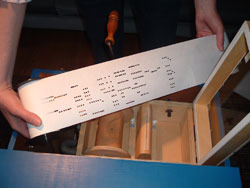 punched cardboard rolls similar to those used in mechanized weaving (Jacquard loom– also the origin of the computer punch-card). The cheap punched cardboard meant variety and variety drew larger crowds.
punched cardboard rolls similar to those used in mechanized weaving (Jacquard loom– also the origin of the computer punch-card). The cheap punched cardboard meant variety and variety drew larger crowds.
“Never hold discussions with the monkey when the organ grinder is in the room.”
~Winston Churchill
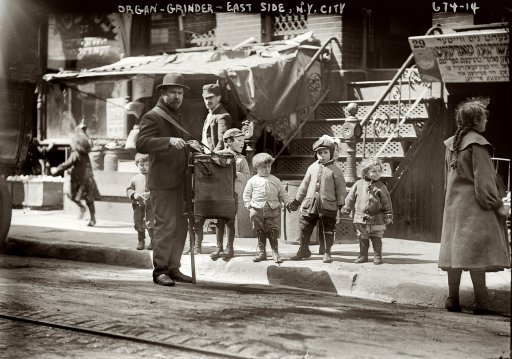 Before I continue, it’s important to note that people often confuse the organ grinder’s instrument with the hurdy gurdy. The latter is actually a string instrument played with keys whereas the organ is a wind instrument that is run rather than played.
Before I continue, it’s important to note that people often confuse the organ grinder’s instrument with the hurdy gurdy. The latter is actually a string instrument played with keys whereas the organ is a wind instrument that is run rather than played.
When one pictures the organ grinder of the Victorian streets, more often that not we see a mustachioed foreigner, perhaps right off the boat that just arrived from some Italian port. It took no particular skill to turn the crank and entertain for pennies. With jobs for immigrants hard to come by, getting yourself one of these gadgets so you could go busk for coin could at least put some food in your belly.
As far as the opinion of upper society went, organ grinders were little better than tinkers and gypsies. They fell in the same class as peddlers, ragmen, and circus performers. In general, how society felt about them was a mixed bag. Their itinerant nature brought news from place to place which was desired, and certainly their cheap entertainment was enjoyed by the working class. However, they were often treated with suspicion, as illustrated by Winston Churchill’s quote, and often for good reason. There are stories from the Victorian era about the organ grinders traveling with pickpocketing children who worked the crowds while the music played. And then there were the animals acts such as the monkey with the little fez who was taught to take off his hat to say thank you for the penny. Sometimes those monkeys, dogs, bears, parrots, etc attacked people.
Though not as easy to come by as it was in its heyday, this street theater hasn’t died out as you might imagine. It turns up at fairs and historical events.
More~
Here’s an article about the aging organ grinders in Mexico City.
An image of a Parisian organ grinder and a very happy child doing her song and dance act. She could also be a shill to be sent out to pick pockets.
The person who posted that video has a youtube channel devoted to organ grinders if you’d like to see and hear more.
:D They make me think of summer which is good. We had snow here just the other day.
Tomorrow ~ letter P
۞>>>>۞<<<<۞>>>>۞<<<<۞
 See what’s happening on the RB4U blog today
See what’s happening on the RB4U blog today
http://romancebooks4us.blogspot.com/
Our April contest is on. We’ll have 3 winners and a lot of prizes to split among them. http://www.romancebooks4us.com/
۞>>>>۞<<<<۞>>>>۞<<<<۞
Love Waits in Unexpected Places -
Scorching Samplings of Unusual Love Stories
https://www.smashwords.com/books/view/333971
Download your copy of my free chapter sampler!

۞>>>>۞<<<<۞>>>>۞<<<<۞>>>>۞<<<< ۞>>>>۞<<<<۞>>>>۞<<<<۞



April 16, 2014
The A to Z Challenge – N for Nebra, Sky Disk
 The A to Z Challenge is on! Hello and welcome to my Main blog. My name is Rose Anderson and I’m a romance novelist. Join me and more than 2279 bloggers and authors as we blog the alphabet throughout the month of April. My daily posts will be mostly history with some science topics here and there. I’ve chosen subjects that tickle my fancy, I hope you will find them interesting too.
The A to Z Challenge is on! Hello and welcome to my Main blog. My name is Rose Anderson and I’m a romance novelist. Join me and more than 2279 bloggers and authors as we blog the alphabet throughout the month of April. My daily posts will be mostly history with some science topics here and there. I’ve chosen subjects that tickle my fancy, I hope you will find them interesting too.
Keep the topic rolling! If you have comments or questions, add them at the end of the post. I may not know the answer off the top of my head but I love research and would enjoy discussing my topics further. Comments can be made just below my bio in the tag section.
*FREE* If you enjoy reading scorching romances with unique twists and characters full of personality and depth, scroll down for a free chapter sampler. Find my book trailers in the tabs above.
۞>>>>۞<<<<۞>>>>۞<<<<۞>>>>۞
 Today’s Calliope’s Writing Tablet post is brought to you by the letter N ~
Today’s Calliope’s Writing Tablet post is brought to you by the letter N ~
N for Nebra Sky Disk
People have lived in Europe a long time. Modern humans only hit the scene around 40,000+ years ago. They eventually absorbed those heavy-boned cousins on our family tree — the early peoples called Neanderthals (named for the Neander valley in Germany where their bones were first discovered). Such stone age peoples have lived across Europe for 300,000 years or longer. Like I said, a long time.
In that lengthy inhabitation early peoples left evidence behind. Sometimes this evidence is small like fire-baked rock from their hearths or stone chips from their tool making. Some things are grander, such as Lascaux and Chauvet Caves, and Stonehenge, Newgrange, Carnac, and other monolithic structures. Others come later like the Roman baths, aqueducts, and Hadrian’s Wall for example. Some things are stumbled upon like the body of English King Richard III, viking swords, and caches of Roman coins. These historical treasures, large and small, have value to mankind for they show us our past. Museums and universities buy them, study them, and put them safely on display that we might know ourselves. Sadly, there are unscrupulous collectors of artifacts and antiquities who, by the very nature of their wants and desires, have created a market for poachers, plunderers, potters, and grave robbers. Archeological sites around the world are destroyed and looted, their goods sold on the black market.
Today’s post begins just that way.
In 1999, two previously-convicted looters were out sweeping the forests of Germany with metal detectors. Just outside the town of Nebra they found a prehistoric enclosure on top of a hill. In it lay an unusual circular object along with a cache of bronze axes and swords. In their zeal to dig them out of the cache, the artifacts were damaged. These men tried to sell their loot on the international market in hopes of snagging the highest payout. Fortunately, German law considers relics state 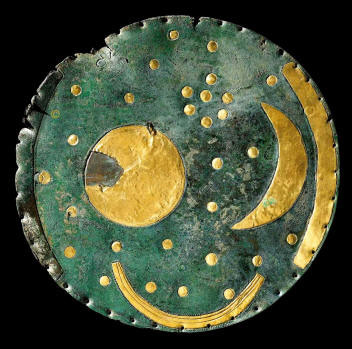 property. The looters were caught in a sting operation in Switzerland when an archaeologist posed as a private collector.
property. The looters were caught in a sting operation in Switzerland when an archaeologist posed as a private collector.
The site in the forest underwent legitimate inventory and is considered one of the most significant and exciting archaeological sites in Europe. What did they find? A 3,600 year-old sky disc — the oldest visual representation of the cosmos known to date. This complex astronomical clock from the Bronze Age is now called the Sky Disc of Nebra, and it just happened to be found near the Goseck Circle, Europe’s oldest observatory.
Here’s how it reads:
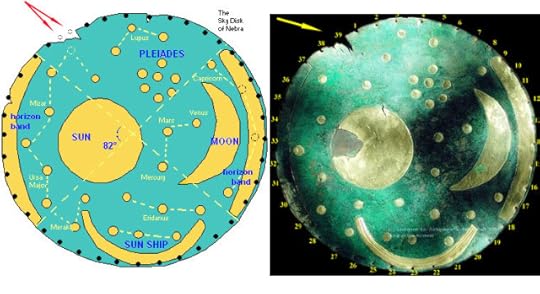 I can’t possibly explain the story better than these BBC broadcasts and the links that follow. Let’s just say wow.
I can’t possibly explain the story better than these BBC broadcasts and the links that follow. Let’s just say wow.
Part 1
Part 2 https://www.youtube.com/watch?v=DAyUpT9nhLQ
Part 3 https://www.youtube.com/watch?v=My_DMV5jMnk
More~
The early Bronze Age explained at the German State Museum
Is it legit? Science tests the metal.
https://www.youtube.com/watch?v=zjWGkgQcq_o
Very interesting
http://www.bbc.co.uk/science/horizon/2004/stardisctrans.shtml
Other interpretations
http://news.bbc.co.uk/2/hi/science/nature/6722953.stm
In 2013, Germany submitted the Nebra Sky Disk for inclusion in the UNESCO Memory of the World Register .
Tomorrow ~ letter O
۞>>>>۞<<<<۞>>>>۞<<<<۞
 Last day for wild foods recipes on my satellite blog!
Last day for wild foods recipes on my satellite blog!
Visit all the participants and win prizes too.
http://calliopeswritingtablet.blogspot.com/
The Authors in Bloom event highlights those things authors do outside the fiction. We garden, we cook, we craft etc. One of the more unusual things my husband and I have done was lead wild foods programs for Chicago’s Field Museum. For this event I’ll be sharing my recipes. Do stop by. You may have delicious ingredients waiting in your backyard!
۞>>>>۞<<<<۞>>>>۞<<<<۞
 See what’s happening on the RB4U blog today
See what’s happening on the RB4U blog today
http://romancebooks4us.blogspot.com/
Our April contest is on. We’ll have 3 winners and a lot of prizes to split among them. http://www.romancebooks4us.com/
۞>>>>۞<<<<۞>>>>۞<<<<۞
Love Waits in Unexpected Places -
Scorching Samplings of Unusual Love Stories
https://www.smashwords.com/books/view/333971
Download your copy of my free chapter sampler!

۞>>>>۞<<<<۞>>>>۞<<<<۞>>>>۞<<<< ۞>>>>۞<<<<۞>>>>۞<<<<۞



April 15, 2014
The A to Z Challenge – M for Medicine Shows & Mountebanks
 The A to Z Challenge is on! Hello and welcome to my Main blog. My name is Rose Anderson and I’m a romance novelist. Join me and more than 2279 bloggers and authors as we blog the alphabet throughout the month of April. My daily posts will be mostly history with some science topics here and there. I’ve chosen subjects that tickle my fancy, I hope you will find them interesting too.
The A to Z Challenge is on! Hello and welcome to my Main blog. My name is Rose Anderson and I’m a romance novelist. Join me and more than 2279 bloggers and authors as we blog the alphabet throughout the month of April. My daily posts will be mostly history with some science topics here and there. I’ve chosen subjects that tickle my fancy, I hope you will find them interesting too.
Keep the topic rolling! If you have comments or questions, add them at the end of the post. I may not know the answer off the top of my head but I love research and would enjoy discussing my topics further. Comments can be made just below my bio in the tag section.
*FREE* If you enjoy reading scorching romances with unique twists and characters full of personality and depth, scroll down for a free chapter sampler. Find my book trailers in the tabs above.
۞>>>>۞<<<<۞>>>>۞<<<<۞>>>>۞
 Today’s Calliope’s Writing Tablet post is brought to you by the letter M ~
Today’s Calliope’s Writing Tablet post is brought to you by the letter M ~
M for Medicine Shows and Mountebanks
I got into a conversation with my husband and daughter the other day. They both watched a recent release of the series Mad Men. I’ve never watched the show, but it’s my understanding it’s about the world of advertising in the middle of the last century. Apparently psychology played a large role in getting people to buy products after the war. We talked about advertising on the scale it is today. I think advertising always contained hype and a bit of fact-bending. As per the habit of the writer’s mind, I wandered with the topic and ended up on a friend of mine. He historically portrays a composite character from an old-time traveling medicine show who “sells” tonics to a a gullible crowd. And so I discarded the topic I’d chosen for M and started anew.
To examine American Traveling Medicine Shows one needs to begin with the mountebanks of Europe. In case you don’t know, a mountebank is a purveyor of quack medicines. In other words a charlatan or a fraud. Mountebanks came into their own in the Middle Ages where they peddled tokens to protect one from the recurring runs of plagues and devils — the usual stuff. During the Renaissance the mountebanks dazzled their crowds with street theater that often include feats of magic, amazing skills and illusions, music, or staged miracles. The idea was to draw them in, then sell to them!
By the 1700′s, the mountebanks were pitching their spiel and selling worthless products to a budding nation. The quackery got so bad in North America that the colonies tried to put an end to them early on. Several colonies successfully passed Acts through their local governing bodies regulating these home made medicines, while other colonies passed Acts for outright suppression of mountebanks.
But in much the same way today’s 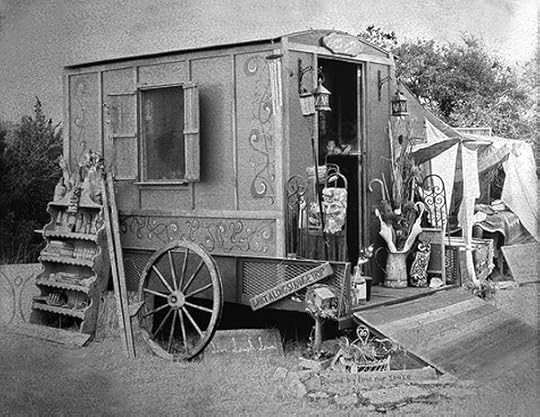 advertisements influence with subliminal sexual gratification, the promises the mountebanks made on behalf of their products were siren’s calls to the gullible or afflicted, and consumers flocked like sheep to buy them.
advertisements influence with subliminal sexual gratification, the promises the mountebanks made on behalf of their products were siren’s calls to the gullible or afflicted, and consumers flocked like sheep to buy them.
There was more at play than promises.
I’ll begin with the shills — those who came into town ahead of the mountebanks and pretended they were in some sorry condition. To gull the crowd, they’d buy the magical elixirs, drink them down on the spot, toss down their crutches and be miraculously “cured”. You can bet a special bottle was set aside just for them. The traveling medicine shows curried legitimacy with costumed characters pretending to belong to the mysterious cultures of the Orient. The Hindu snake handlers, 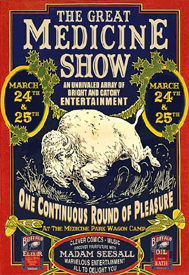 Egyptian belly dancers, sheiks, fakirs and more brought a worldliness to rural America. If it was good enough for the Sheik’s back ache, then it was good enough for old Tom the barber. That extra marketing charisma was an irresistible carrot dangling on a stick.
Egyptian belly dancers, sheiks, fakirs and more brought a worldliness to rural America. If it was good enough for the Sheik’s back ache, then it was good enough for old Tom the barber. That extra marketing charisma was an irresistible carrot dangling on a stick.
Home remedies at the time often followed the ancient belief in the doctrine of signatures . That is, if a leaf is shaped like a liver then it must treat the liver. Snakes, for example, slithered effortlessly on their healthy spine, therefore snake oil must be good for rheumatism. Often real medicines and tinctures tasted bitter so medicine show tonics had bitter ingredients added to lend a bit of authenticity. Cocaine and opium were common additives, as were turpentine, creosote, stump water, and bitters. Mostly, they contained alcohol. In some states were Blue Laws were on the books, you couldn’t buy spirits on the weekends, but you could buy that tonic that kicked like a mule.
Inventing problems the tonics and elixirs are alleged to solve.
In their mesmerizing sales pitches, some pretty 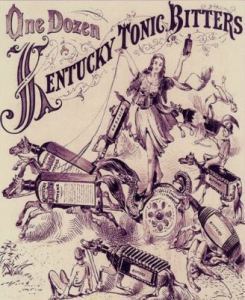 outrageous promises were made. Eliminating baldness and being irresistible to the fairer sex were the benign claims. Curing tuberculosis, diphtheria, venereal diseases, infant colic and digestive problems, female complaints of all sorts, and even as a cure for cancer, were all found in this one bottle and it only cost you a few pennies… and a little blind faith. Bottles were purchased and business was good. Before you knew it the medicine show had gone. Speed was important lest someone become ill or drunk, as they often did. Children, the elderly, and the infirm were dosed. Often with tragic consequences.
outrageous promises were made. Eliminating baldness and being irresistible to the fairer sex were the benign claims. Curing tuberculosis, diphtheria, venereal diseases, infant colic and digestive problems, female complaints of all sorts, and even as a cure for cancer, were all found in this one bottle and it only cost you a few pennies… and a little blind faith. Bottles were purchased and business was good. Before you knew it the medicine show had gone. Speed was important lest someone become ill or drunk, as they often did. Children, the elderly, and the infirm were dosed. Often with tragic consequences.
On the flip side, some common old-timey patent medicines actually became household products with a genuine following for their efficacy. I remember some oldies were still on the drug store shelves when I was a kid. We know them today as Fletcher’s Castoria, Ex-Lax, Absorbine Jr., Doan’s Pills, Geritol, Bromo-Seltzer, Carter’s Little Pills, Vick’s VapoRub, Smith Brothers Throat Drops, Philips’ Milk of Magnesia, and who doesn’t know Bayer Aspirin and Anacin?
After centuries of charlatanism, the Pure Food and Drug Act was enacted in 1906 requiring manufacturers to list their ingredients on labels and restrict misleading advertising claims. In 1938, safety testing came into being. In 1962, effectiveness testing was required. And so, the snake oil and the snake oil salesman left the scene. But if you look closely, you’ll see they’re still out there making up the ads and commercials that bombard our lives each day.
More~
Here’s a good friend of mine playing his alter ego — a colonial mountebank.
Fun to Note: Towards the end he makes music with two sets of bones. He taught me to play. I’m nowhere near that good. :)
Here’s a later example of the medicine show quack. He does a very good job as a slick talker. Imagine him with his cart in 1870′s rural Iowa or Oklahoma and the purses emptying to buy his elixirs.
More From the Oklahoma Historical Society
Fast Fact: In their book Freakonomics, authors Steven Levitt and Stephen Dubner point their finger at Listerine as the source of today’s shame-based selling. I say shame-based because we once lived in a haze of child-like innocence unaware of the abject offensiveness of split-ends, graying hair, sweaty underarms, stained teeth, dandruff, ring around the collar, bad breath and more. Fortunately, the makers of Listerine clued us in at the turn of the last century. And it grew more outrageous as time went on. Even Lysol was sold as a douche. Seriously.
Tomorrow ~ letter N
۞>>>>۞<<<<۞>>>>۞<<<<۞
 Last Week for wild foods recipes on my satellite blog!
Last Week for wild foods recipes on my satellite blog!
http://calliopeswritingtablet.blogspot.com/
The Authors in Bloom event highlights those things authors do outside the fiction. We garden, we cook, we craft etc. One of the more unusual things my husband and I have done was lead wild foods programs for Chicago’s Field Museum. For this event I’ll be sharing my recipes. Do stop by. You may have delicious ingredients waiting in your backyard!
۞>>>>۞<<<<۞>>>>۞<<<<۞
 See what’s happening on the RB4U blog today
See what’s happening on the RB4U blog today
http://romancebooks4us.blogspot.com/
Our April contest is on. We’ll have 3 winners and a lot of prizes to split among them. http://www.romancebooks4us.com/
۞>>>>۞<<<<۞>>>>۞<<<<۞
Love Waits in Unexpected Places -
Scorching Samplings of Unusual Love Stories
https://www.smashwords.com/books/view/333971
Download your copy of my free chapter sampler!

۞>>>>۞<<<<۞>>>>۞<<<<۞>>>>۞<<<< ۞>>>>۞<<<<۞>>>>۞<<<<۞



April 14, 2014
The A to Z Challenge – L for London Fog of 1952
 The A to Z Challenge is on! Hello and welcome to my Main blog. My name is Rose Anderson and I’m a romance novelist. Join me and more than 2279 bloggers and authors as we blog the alphabet throughout the month of April. My daily posts will be mostly history with some science topics here and there. I’ve chosen subjects that tickle my fancy, I hope you will find them interesting too.
The A to Z Challenge is on! Hello and welcome to my Main blog. My name is Rose Anderson and I’m a romance novelist. Join me and more than 2279 bloggers and authors as we blog the alphabet throughout the month of April. My daily posts will be mostly history with some science topics here and there. I’ve chosen subjects that tickle my fancy, I hope you will find them interesting too.
Keep the topic rolling! If you have comments or questions, add them at the end of the post. I may not know the answer off the top of my head but I love research and would enjoy discussing my topics further. Comments can be made just below my bio in the tag section.
*FREE* If you enjoy reading scorching romances with unique twists and characters full of personality and depth, scroll down for a free chapter sampler. Find my book trailers in the tabs above.
۞>>>>۞<<<<۞>>>>۞<<<<۞>>>>۞
 Today’s Calliope’s Writing Tablet post is brought to you by the letter L ~
Today’s Calliope’s Writing Tablet post is brought to you by the letter L ~
L for London Fog of 1952
As a child visiting relatives in San Fransisco in the 1960′s, I remember watching the fog roll in off the ocean. It was exciting for this Midwestern girl to see such an awe-inspiring thing. As if the ocean wasn’t amazing on its own. The fog came rolling in like a cloud wall until you could only see a few feet in front of you. That’s basically what fog is — a ground cloud. It’s my understanding that the atmospheric conditions concocting a heavy  fog only requires a 4° difference between air temperature and dew point. Air cooled to the dewpoint can no longer hold all of the water vapor it contains. Water droplets condense, and that makes fog. Were these ground clouds in the cold upper sky instead, we might have rain. Weather creates extraordinary phenomena.
fog only requires a 4° difference between air temperature and dew point. Air cooled to the dewpoint can no longer hold all of the water vapor it contains. Water droplets condense, and that makes fog. Were these ground clouds in the cold upper sky instead, we might have rain. Weather creates extraordinary phenomena.
The weather conditions that came into play over the UK in December back in 1952 created a fog of another kind — a killer fog.
Smoke + fog = smog
Earliest Roman accounts mention the fogginess of Britain. Islands often have heavy mists and fogs. They’re called advection fog — air that’s been warmed over land meets the cold surface of the ocean. As Britain is surrounded by sea, so common are fogs to this island, the fogs even have names. Along the Northumbrian coast the fog is called the fret. In the southeaster portion of Scotland it’s the haar.
With much of the land deforested in its long inhabitation, the populace turned to peat and coal to cook with and warm their hearths. This put soot into the foggy air. So heavy and persistent the smoggy fog of 1807, Charles Dickens wrote it into his novel Bleak House. A popular name for the fog during that time was the London particular. In 1813, a fog “smelling of coal tar” was so unrelenting, the prince regent on his outing had to turn his carriage around and go home.
Not just a bad smell
The economic recovery came slow during  the post-war reconstruction and money was tight. Around 1952 London had just given up its electric buses for cheaper diesel. At the time, the nation’s high-grade cleaner-burning coal was exported and Londoners were left to burn a lesser-grade high-sulfur coal to heat their homes. From here I’ll paint you a picture…
the post-war reconstruction and money was tight. Around 1952 London had just given up its electric buses for cheaper diesel. At the time, the nation’s high-grade cleaner-burning coal was exported and Londoners were left to burn a lesser-grade high-sulfur coal to heat their homes. From here I’ll paint you a picture…
The cold fog rolled in December 4th and Londoners paid it little mind. As mentioned above, fogs and mists were a regular feature in their lives. An early cold snap saw coal-fired plants and houses cranking up the heat. As midday approached, the fog mixed with thousands of tons of soot in the air and soon took on a yellowish cast. Little did anyone realize this fog wouldn’t be clearing anytime soon. A temperature inversion had formed 1000 feet above the city and acted like a dome that trapped the noxious air inside. But it was cold and the factories and homes continued to burn their cheap coal. Before long a 30-mile wide blanket of sulfurous carbon monoxide stink enveloped London.
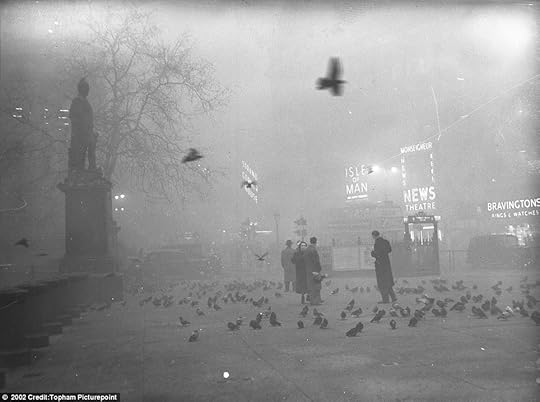 For four days the entire city was immobilized by this toxic fog. River traffic stopped as did all transportation outside of the London Underground. At one point, men walked with lanterns ahead of the buses for a time to keep traffic moving, but that too stopped cold. Schools closed. Movie theaters closed because patrons couldn’t see the screens. Accounts in some parts of the city say people couldn’t see their hand before their eyes nor their feet as they walked. Worse, death had come.
For four days the entire city was immobilized by this toxic fog. River traffic stopped as did all transportation outside of the London Underground. At one point, men walked with lanterns ahead of the buses for a time to keep traffic moving, but that too stopped cold. Schools closed. Movie theaters closed because patrons couldn’t see the screens. Accounts in some parts of the city say people couldn’t see their hand before their eyes nor their feet as they walked. Worse, death had come.
A black oily soot smudged faces and every corner of London. Several prize heifers died at the famous Sheffield Show. In desperation, farmers took to rigging makeshift gas masks for their animals. People too were beginning to perish. Initial estimates put the death toll at 4000, mainly those with respiratory problems, infants, and the elderly. On December 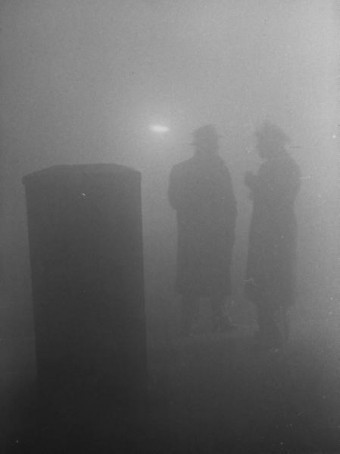 9th, a cold wind blew the the smog out to sea. The after-effects lingered and the death toll rose to approximately 12,000.
9th, a cold wind blew the the smog out to sea. The after-effects lingered and the death toll rose to approximately 12,000.
Unbelievably, change came slow. Though an investigation determined they had a serious pollution problem, the government didn’t want to change things at first. It took nearly four years for Parliament to pass the Clean Air Act of 1956 that restricted coal burning in urban areas. Transitioning from coal to gas, oil, and electricity took years and during that time other deadly fogs would come. The killer fog of1962 claimed 750 lives.
~More~
They had an idea something was wrong before the tragedy of 1952.
Here’s another clip
An extra 2⊄: Mankind is certainly a short-sighted creature. In my portion of the world we have politicians determined to repeal the Clean Air Act. As an environmentalist, this infuriates me because it’s all profit motivated. Yes, money talks. It always has. But what good is money if breathing, a process so necessary to life, becomes impossible? One need only look at China where air pollution is choking the populace even as I write this. We’d all better make some changes soon.


“Water and air, the two essential fluids on which all life depends,
have become global garbage cans.”
~ Jacques-Yves Cousteau
Tomorrow ~ letter M
۞>>>>۞<<<<۞>>>>۞<<<<۞
 Last Week for wild foods recipes on my satellite blog!
Last Week for wild foods recipes on my satellite blog!
http://calliopeswritingtablet.blogspot.com/
The Authors in Bloom event highlights those things authors do outside the fiction. We garden, we cook, we craft etc. One of the more unusual things my husband and I have done was lead wild foods programs for Chicago’s Field Museum. For this event I’ll be sharing my recipes. Do stop by. You may have delicious ingredients waiting in your backyard!
۞>>>>۞<<<<۞>>>>۞<<<<۞
 See what’s happening on the RB4U blog today
See what’s happening on the RB4U blog today
http://romancebooks4us.blogspot.com/
Our April contest is on. We’ll have 3 winners and a lot of prizes to split among them. http://www.romancebooks4us.com/
۞>>>>۞<<<<۞>>>>۞<<<<۞
Love Waits in Unexpected Places -
Scorching Samplings of Unusual Love Stories
https://www.smashwords.com/books/view/333971
Download your copy of my free chapter sampler!

۞>>>>۞<<<<۞>>>>۞<<<<۞>>>>۞<<<< ۞>>>>۞<<<<۞>>>>۞<<<<۞



April 13, 2014
Funday Sunday, weekend happenings & the last word
The A to Z returns Monday with letter L. Today is Funday!
I lead a busy life. To have one less mentally-busy day and still have a good time on this blog, I’ve decided Sundays will be all about wonder and smiles. In honor of mentally kicking back once in a while, Sundays will be Fun Days! Each Sunday, I’ll post a short, fun or unusual something here. I’m a nerd with a complex sense of humor and absurd wit. It literally could be anything.
April is mathematics month. In honor of that let’s celebrate
a surprising digit — the number nine. I find it interesting!
:D
Come back tomorrow for more of the A to Z Challenge. Monday’s letter ~ L.
۞>>>>۞<<<<۞>>>>۞
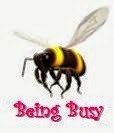 What’s up Saturday & Sunday?
What’s up Saturday & Sunday?
I’m posting offerings on my satellite blogs this weekend. If two things are listed for one blog, that’s one on Saturday and one on Sunday
. Scroll back to see what you’ve missed.
Authors in Bloom
http://calliopeswritingtablet.blogspot.com/
Seductive Studs & Sirens
& Weekend Writing Warriors
http://theancillarymuse.blogspot.com/
Sneak Peek Sunday
http://ifollowthemuse.blogspot.com/
Saturday’s After Dark Moments & Sexy Snippets
http://calliopesotherwritingtablet.blogspot.com/
The Sunday Preview – Promo opportunity for romance authors.
Stop by my group blog and leave your preview!
http://exquisitequills.blogspot.com/
۞>>>>۞<<<<۞>>>>۞
Today I post the last word in the 100 Things Blogging Challenge!
For 100 days,
I’ve posted something from my chosen topic: Words on the Verge of Extinction.
:D
Gardevisure (noun 1610-1840)
~visor of a helmet as shown on heraldic devices
۞>>>>۞<<<<۞>>>>۞
 See what’s happening on the RB4U blog today
See what’s happening on the RB4U blog today
http://romancebooks4us.blogspot.com/
Our April contest is on. We’ll have 3 winners and a lot of prizes to split among them. http://www.romancebooks4us.com/
۞>>>>۞<<<<۞>>>>۞
Love Waits in Unexpected Places -
Scorching Samplings of Unusual Love Stories
https://www.smashwords.com/books/view/333971
Download your copy of my free chapter sampler!

۞>>>>۞<<<<۞>>>>۞<<<<۞>>>>۞<<<< ۞>>>>۞<<<<۞

April 12, 2014
The A to Z Challenge – K for Kokopelli
 The A to Z Challenge is on! Hello and welcome to my Main blog. My name is Rose Anderson and I’m a romance novelist. Join me and more than 2279 bloggers and authors as we blog the alphabet throughout the month of April. My daily posts will be mostly history with some science topics here and there. I’ve chosen subjects that tickle my fancy, I hope you will find them interesting too.
The A to Z Challenge is on! Hello and welcome to my Main blog. My name is Rose Anderson and I’m a romance novelist. Join me and more than 2279 bloggers and authors as we blog the alphabet throughout the month of April. My daily posts will be mostly history with some science topics here and there. I’ve chosen subjects that tickle my fancy, I hope you will find them interesting too.
Keep the topic rolling! If you have comments or questions, add them at the end of the post. I may not know the answer off the top of my head but I love research and would enjoy discussing my topics further. Comments can be made just below my bio in the tag section.
*FREE* If you enjoy reading scorching romances with unique twists and characters full of personality and depth, scroll down for a free chapter sampler. Find my book trailers in the tabs above.
۞>>>>۞<<<<۞>>>>۞<<<<۞>>>>۞
 Today’s Calliope’s Writing Tablet post is brought to you by the letter K ~
Today’s Calliope’s Writing Tablet post is brought to you by the letter K ~
K for Kokopelli
I’ve said before that I am a drummer. My husband and friends gather regularly to make music together. Besides a variety of drums, we have all sorts of percussion instruments and unusual rhythm makers from all over the world. Sometimes we make music indoors, other times we drum and dance in the moonlight. As we have the largest yard to accommodate such a gathering, we host full moon drummings at my house. That includes the notable Blue Moon — those extra moons in the year. More times than not we entrain when we really get going — that is, our brains synchronize. Some future post I’ll explain the science behind that. One of the strange things about entrainment is the ability to all stop together without any lead up to let you know the music is winding down. It also leaves you feeling rather high to have your brainwaves mingling with other brainwaves. Gotta love science. :D
It was after such a brain bonding on a full moon night that I saw something on the moon.
People often see things on the moon, images like the rabbit, the man in the moon, the sitting woman. Depending what image your culture says is there, that’s what you’ll see, just as we see things in cloud formations. This flight of fancy is called pareidolia. There’s a science in this too. Humans are hard-wired to look for faces. I suspect it has to do with bonding as in baby and mother bonding. But I digress. Back to the moon…
So on that wild drumming night the moon was huge and bright, so bright in fact that at 2:30 in the morning you could hear birds making little chirping sounds as they tried to determine if dawn had come early. I looked at that moon and saw him. It wasn’t the rabbit, the woman or the man in the moon face. It was Kokopelli. I was seized with an overwhelming case of surety that told me that sometime in the past, an aboriginal storyteller in North America looked up and saw the dancing flute player.
Ive scoured the web looking for a comparable moon to show here and gave up after so many pages of images. Online images don’t show a clear Kokopelli. This is a rough attempt to show what I saw. It takes skill to draw with a computer’s mouse and that’s a skill I just don’t possess.
Who is Kokopelli?
It’s said Kokopelli is a Kachina, a spirit being in the pantheon of Southwest Native American deities known for music, dance, and mischief. The ancient Anasazi considered him a god but his origins are thought to be older still. Ancient rock carvings and paintings, a.k.a. petroglyphs, date him at 3,000 or so years.
Depending on which peoples you ask, the humpbacked dancing flute player has different meanings attributed to him. Generally, this kachina is thought to carry a sack on his back like a traveler or trader. In legends, the sack carries everything from unborn babies to seeds to other gifts. His flute is said to be a nose flute (yes there really are such things). The melody on his flute would bring rain, melt snow, and the change the seasons.
In keeping with those babies on his back, he’s also associated with replenishment and fertility. Some of the petroglyphs show him dancing with a substantial erection. Legend says when Kokopelli played his flute everyone would sing and dance all through the night. Come morning every maiden in the village would be with child. There have been no such surprises for my drummer friends.
Here’s an example of the nose flute
My son gave me his head cold for my birthday last week. Needless to say, I’m writing this through a brain fog. Sorry for the late post.
Tomorrow it’s Funday Sunday and on Monday ~ letter L!
۞>>>>۞<<<<۞>>>>۞<<<<۞
 **NEW THIS WEEK** on my satellite blog!
**NEW THIS WEEK** on my satellite blog!
http://calliopeswritingtablet.blogspot.com/
It’s Day6 in the Authors in Bloom event. It highlights those things authors do outside the fiction. We garden, we cook, we craft etc. One of the more unusual things my husband and I have done was lead wild foods programs for Chicago’s Field Museum. For this event I’ll be sharing my recipes. Do stop by. You may have delicious ingredients waiting in your backyard!
۞>>>>۞<<<<۞>>>>۞<<<<۞
It’s the final stretch in the 100 Things Blogging Challenge!
For nearly 100 days,  I’ve posted from my chosen topic: Words on the Verge of Extinction. Just 1 entry to come!
I’ve posted from my chosen topic: Words on the Verge of Extinction. Just 1 entry to come!
Here’s one for today:
Essomenic (adjective 1771)
~showing things as they will be in the future
۞>>>>۞<<<<۞>>>>۞<<<<۞
 See what’s happening on the RB4U blog today
See what’s happening on the RB4U blog today
http://romancebooks4us.blogspot.com/
Our April contest is on. We’ll have 3 winners and a lot of prizes to split among them. http://www.romancebooks4us.com/
۞>>>>۞<<<<۞>>>>۞<<<<۞
Love Waits in Unexpected Places -
Scorching Samplings of Unusual Love Stories
https://www.smashwords.com/books/view/333971
Download your copy of my free chapter sampler!

۞>>>>۞<<<<۞>>>>۞<<<<۞>>>>۞<<<< ۞>>>>۞<<<<۞>>>>۞<<<<۞



April 11, 2014
The A to Z Challenge – J for Jug Band
 The A to Z Challenge is on! Hello and welcome to my main blog. My name is Rose Anderson and I’m a romance novelist. Join me and more than 2279 bloggers and authors as we blog the alphabet throughout the month of April. My daily posts will be mostly history with some science topics here and there. I’ve chosen subjects that tickle my fancy, I hope you will find them interesting too.
The A to Z Challenge is on! Hello and welcome to my main blog. My name is Rose Anderson and I’m a romance novelist. Join me and more than 2279 bloggers and authors as we blog the alphabet throughout the month of April. My daily posts will be mostly history with some science topics here and there. I’ve chosen subjects that tickle my fancy, I hope you will find them interesting too.
Keep the topic rolling! If you have comments or questions, add them at the end of the post. I may not know the answer off the top of my head but I love research and would enjoy discussing my topics further. Comments can be made just below my bio in the tag section.
*FREE* If you enjoy reading scorching romances with unique twists and characters full of personality and depth, scroll down for a free chapter sampler. Find my book trailers in the tabs above.
۞>>>>۞<<<<۞>>>>۞<<<<۞>>>>۞
 Today’s Calliope’s Writing Tablet post is brought to you by the letter J ~
Today’s Calliope’s Writing Tablet post is brought to you by the letter J ~
J for Jug Band
I heard a story recently about how an abundance of empty whiskey jugs from the bourbon-fragrant streets of Louisville Kentucky led to an American music form — jug band. I don’t know if that’s true or not, but it’s a cute story.
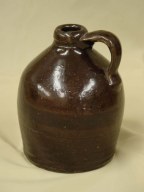 The musical pastiche of jug band was at its root a poor man’s pastime. You didn’t need money when love of music and sheer joy played tunes on anything one could wrangle a tune out of. As a world drummer who finds music latent in all sorts of things, I understand this. I play a few odd instruments myself — spoons and bones, and a washboard with thimbles. I’ve even played tabletops, glass bottles, and the occasional iron gate! Needless to say, jug band intrigues me. :D
The musical pastiche of jug band was at its root a poor man’s pastime. You didn’t need money when love of music and sheer joy played tunes on anything one could wrangle a tune out of. As a world drummer who finds music latent in all sorts of things, I understand this. I play a few odd instruments myself — spoons and bones, and a washboard with thimbles. I’ve even played tabletops, glass bottles, and the occasional iron gate! Needless to say, jug band intrigues me. :D
Instruments were mostly home made: washboards 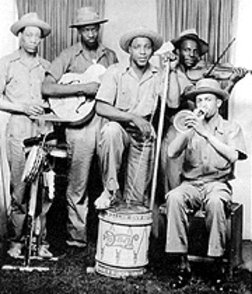 and scraping thimbles kept time. Mouths blowing into empty jugs produced tuba sounds. Washtubs or gut-buckets played bass while cigar-box or gourd-bottom fiddles, bowed saws, spoons, and paper-on-comb kazoos played melody. If you were lucky, a neighbor might join in with a real guitar, banjo, or harmonica. Jug band music was popular in the old vaudeville days between 1880 and the 1930′s, and often appeared in traveling medicine shows, on riverboats, and in southern honky-tonks.
and scraping thimbles kept time. Mouths blowing into empty jugs produced tuba sounds. Washtubs or gut-buckets played bass while cigar-box or gourd-bottom fiddles, bowed saws, spoons, and paper-on-comb kazoos played melody. If you were lucky, a neighbor might join in with a real guitar, banjo, or harmonica. Jug band music was popular in the old vaudeville days between 1880 and the 1930′s, and often appeared in traveling medicine shows, on riverboats, and in southern honky-tonks.
I think one of the coolest things about this improvised music style was how it influenced other music such as Jazz, the Blues and eventually Rock. Examine it further and you’ll see American skiffle and that musical style eventually influenced the Beatles. Skiffle, by the way, was “rent party” music. Gathering musicians together and charging a few cents to hear them allowed you to make your rent payment — a popular idea in the 1920′s. I know a young couple who do that today, quite successfully too.
So many music greats started in jug band. Bands like Jimmy Bertrand’s Washboard Wizards, Clarence Williams’ Seven Gallon Jug Band and Washboard Five, The Mound City Blue Blowers, Ma Rainey’s Tub-jug Band, and many more, gave a start to several music legends. Greats like Louis Armstrong, King Oliver, Jimmy Dorsey, Gene Krupa, and Glen Miller all cut their musical teeth here.
The USA and Great Britain saw a Jug band revival in the 1950′s.
Few people know the effect of jug band on the music we grew up on. The Even Dozen Jug Band had musicians John Sebastion and Steve Katz. John Sebastion went on to form The Lovin’ Spoonful and Steve Katz joined Blood Sweat and Tears. Zal Yanovsky of The Lovin’ Spoonful got his start in The Mugwamps Jug Band as did Cass Elliot and Denny Dougherty who later formed The Mommas and the Papas. Gerry Garcia from Mother McCree’s Jug Champions went on to form the Grateful Dead. My favorite, The Nitty Gritty Dirt Band, had John McEuen and is still pickn’ and grinnin’.
In the UK, the Midnight Special Skiffle Band had Van Morrison who was also in the Sputniks Skiffle Band. The Kingston’s Bucktown Skiffle Group had Mick Jagger. Singer Cliff Richards sang in the Dick Teague Skiffle Group. A whole slew of folk musicians played Skiffle and so did Rock musicians like Roger Daltrey, Jimmy Page, David Gilmour, and Robin Trower. Graham Nash and Allan Clarke of The Hollies were all in lesser Skiffle bands. Ringo Star also played in the Eddie Clayton Skiffle Group around the same time John Lennon was forming The Quarrymen Skiffle Band with Paul McCartney and George Harrison which eventually became the Beatles. From here on is a post for another day…
More~
Here’s an interesting trailer for a documentary called Chasin’ Gus’ Ghost about Gus Cannon and the impact of jug band on other music.
My washboard needs some spiffing up!
David Holt can teach you to play some unusual instruments, and youtube is filled with his videos. I could spend all day watching him. I once saw him play a bag of potato chips. Now that’s improvisation.
I had such a hard time choosing the visuals for today’s post. There so many terrific examples online. If you want to smile, look up the Yokohama Jug-Band Festival on youtube.
Tomorrow ~ letter K!
۞>>>>۞<<<<۞>>>>۞<<<<۞
 **NEW THIS WEEK** on my satellite blog!
**NEW THIS WEEK** on my satellite blog!
http://calliopeswritingtablet.blogspot.com/
It’s Day5 in the Authors in Bloom event. It highlights those things authors do outside the fiction. We garden, we cook, we craft etc. One of the more unusual things my husband and I have done was lead wild foods programs for Chicago’s Field Museum. For this event I’ll be sharing my recipes. Do stop by. You may have delicious ingredients waiting in your backyard!
۞>>>>۞<<<<۞>>>>۞<<<<۞
It’s the final stretch in the 100 Things Blogging Challenge!
For nearly 100 days,  I’ve posted from my chosen topic: Words on the Verge of Extinction. There are 2 entries to come.
I’ve posted from my chosen topic: Words on the Verge of Extinction. There are 2 entries to come.
Here’s one for today:
Ectylotic (adjective 1736-1864)
removing warts or calluses
۞>>>>۞<<<<۞>>>>۞<<<<۞
 See what’s happening on the RB4U blog today
See what’s happening on the RB4U blog today
http://romancebooks4us.blogspot.com/
Our April contest is on. We’ll have 3 winners and a lot of prizes to split among them. http://www.romancebooks4us.com/
۞>>>>۞<<<<۞>>>>۞<<<<۞
Love Waits in Unexpected Places -
Scorching Samplings of Unusual Love Stories
https://www.smashwords.com/books/view/333971
Download your copy of my free chapter sampler!

۞>>>>۞<<<<۞>>>>۞<<<<۞>>>>۞<<<< ۞>>>>۞<<<<۞>>>>۞<<<<۞









